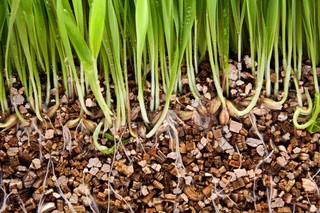Vermiculite: Uses for growing plants, safety, and comparison to Perlite

Anyone who has ever worked with a potting soil mix has probably noticed those little “blocks” or chunks of gold it contains. Light and airy, these particles are known as vermiculite, an important product in gardening (and many other industries). While they may not be worth their weight in gold they are highly revered for their numerous benefits.
How Vermiculite is made
Similar in nature to perlite, vermiculite is formed by the weathering or heating of biotite or phlogopite. These rocks are considered phyllosilicates, containing high proportions of magnesium aluminum silicate mineral that resembles mica in appearance. A typical chemical analysis of commercial vermiculite shows it contains 38-46% silicon oxide (SiO2), 16-35% magnesium oxide (MgO), 10-16% aluminum oxide (Al2O3), 8-16% water, plus lesser amounts of several other chemicals.
After mining, the ore is separated from other minerals and screened to classify it into different particle sizes. Like perlite, these different sizes comprise the different grades of vermiculite: large, medium, fine, superfine and micron. The most commonly used sizes are 0–2, 2–4, and 4–8 mm in diameter.[1]
The particles are then superheated in a process called exfoliation[2] to create elongated, accordion-like particles. Expanded vermiculite is typically golden brown in color.
Two features of vermiculite lead to its unique shape and numerous uses.
- A layered, crystalline structure within the mineral provides the hinged plates that make the material expand or unfold in a linear manner, like an accordion, when heated.
- Trapped water flashes into steam when heated, forcing the layers open.

Uses of Vermiculite
Both treated and untreated vermiculite are used across a variety of industries, for many different purposes. Expanded vermiculite is versatile and unique: it is lightweight, it is non-combustible, compressible, highly absorbent, pH neutral, inert, and non-reactive to all but very strong acids.
-
Gardening - helps with water retention, soil aeration, and drainage. Used as the sole growing media in containers, or a component of potting soil; also used as a soil amendment for garden soils. You can shop now on Amazon, Espoma is our favorite brand currently.
-
Animal feed - works well as carrying medium for certain types of nutrients: vitamin preparations, fat concentrations, and molasses.
-
Packing material - commonly used when shipping hazardous liquids. Highly absorbent so it will soak up any leaks that occur; non-flammable nature contains fires (when packaging items such as lithium batteries) to inside the container. Unlike standard packing peanuts, it breaks down naturally in landfills.
-
Automotive - used to make brake and clutch linings, gaskets, and rubber seals. When ground, into a powder it can be used in auto paints and lacquers.
-
Construction - used to manufacture plasters, loose-fill insulation, and lightweight concrete used for floors and roofs.
Pros and cons
As with other products such as perlite, peat moss, and coconut coir, vermiculite has both its advantages and disadvantages. In the horticulture industry, the advantages far outweigh the downfalls.
Pros:
- pH close to neutral.
- High water retention.
- Takes a long time for particles to dry out so the root zone stays wet longer.
- Holds onto nutrients well (high cation exchange capacity) because of platy structure.
- It can be used alone or mixed with other media to create potting mixes.
- Its sterile nature makes it highly suitable for starting seeds. There is little risk of root rot or damping-off.[3]
- Great for seed germination or plant propagation as the particles let plants be pulled from the perlite without damage to the root systems when it’s time for transplanting.
- Reusable year after year since it doesn’t decompose.
Cons:
- Holds onto too much moisture for some plants.
- Carbonate compounds foster alkaline reactions, raising pH in the root zone.
- Nonrenewable resource. Although more readily available than peat moss, it isn’t considered renewable like coconut coir.
- Difficult to find in the retail home gardening marketplace.

When to use Vermiculite for plants
When not used as a soil conditioner, or as an ingredient in a soilless potting mix, there are three other situations vermiculite is useful for plants.

The enthusiast's guide to herbs
We’re proud to present our new e-book, The Enthusiast’s Guide to Herbs! Learn everything you need to know about growing and caring for herbs indoors, including in-depth info cards for the 35 most commonly grown herbs.
Click the link below to find out more!
Sole growing media
Vermiculite is used as a growing media for seed starting and rooting propagated cuttings because of its sterile nature and ability to retain moisture without encouraging damping-off. All plants can be started - from seeds or cuttings - using vermiculite as the sole growing media. When the time comes to pot up plants into containers some will thrive growing solely in vermiculite, some prefer other types of growing media for maximum plant growth.
Herbs that prefer moist soils that thrive in vermiculite:
- Basil
- Coriander
- Parsley
Moisture-loving plants that thrive in vermiculite:
- Ferns
- Spider plant
- Pothos
- Philodendron
- Lucky bamboo
Seeding new lawns
One of the critical aspects of establishing a new lawn is keeping seeds moist while they germinate. When seeding new lawns spread ¼” layer across the newly seeded area, then irrigate well. The vermiculite helps to hold water close to the seeds as they sprout.
Storing bulbs
Tender varieties of bulbs are dug up in the late fall and then stored in a cool, dry place over the winter. Layer bulbs in-between vermiculite before storing. It will soak up excess moisture without desiccating the bulbs.

Vermiculite versus Perlite
Again, many gardeners wonder if there is a big difference between vermiculite and perlite and if they can be substituted for one another. Unfortunately, while they have some similar properties they act very differently.
The biggest difference between the two products is that perlite helps increase the drainage, while vermiculite increases water retention by absorbing water in its plate-like structure and holding it in the root zone for plant roots. Use perlite when you are growing plants that benefit from the growing media drying out completely between waterings (succulents, orchids); use vermiculite when you are growing plants that prefer to be kept moist such as tropical plants.
When using them as ingredients in potting mixes or as a soil amendment, perlite and vermiculite act as complements to one another versus alternatives.
A quick note about safety
For about 70-years, an estimated 70-80% of all vermiculite sold in the United States came from the Libby Mine, in Libby, Montana. The vermiculite deposit was found to have naturally occurring asbestos minerals directly alongside the vermiculite. When mined by the Zonolite Company, Libby Amphibole asbestos (LAA) contaminated the product, creating health and safety concerns, especially with vermiculite being used in attic insulation and as raw materials in many other construction products.
Asbestos exposure is incredibly dangerous, posing many health risks. When inhaled, asbestos fibers enter the lungs and are known to cause lung cancer, mesothelioma, and other lung diseases.
This mine was closed in 1990; in 1999 the Environmental protection Agency (EPA) stepped in to investigate concerns from local citizens and begin remediation. The Libby cleanup project has been one of the largest, longest-running, remediation projects to date.
According to The Vermiculite Association, all vermiculite mined and used today is mined under strict protocols to ensure its safety.
Conclusion
Known for its sterile, lightweight nature and ability to retain moisture, improve aeration, and increase drainage, vermiculite is an invaluable asset to the horticultural industry. It is typically used for germinating seeds and rooting cuttings, as an ingredient in soilless growing media, and as a soil conditioner for garden soil. Known to be inexpensive, effective, and safe for use, it is a great tool to keep in your gardening arsenal.

Join our email club—get printable info cards free!
Sign up to receive our newsletter and get access to 10 printable plant info cards from our e-book for free. Also receive:
- $4 discount code for our Guide to Herbs e-book
- Semi-weekly plant inspiration & bite-size tips and tricks
Bar-Tal, A., Saha, U. K., Raviv, M., & Tuller, M. (2010). Chapter 7 - Inorganic and Synthetic Organic Components of Soilless Culture and Potting Mixtures. In M. Raviv, J. Heinrich Lieth, & A. Bar-Tal (Eds.), Soilless Culture (pp. 259-301). Amsterdam, Netherlands: Elsevier. doi:10.1016/B978-0-444-63696-6.00007-4 ↩︎
Hillier, S., Marwa, E., & Rice, C. (2013). On the mechanism of exfoliation of ‘Vermiculite’. Clay Minerals, 48(4), 563-582. doi:10.1180/claymin.2013.048.4.01 ↩︎
Horst, R. K. (2013). Damping-Off. In Westcott’s Plant Disease Handbook. Dordrecht, Netherlands: Springer. doi:10.1007/978-94-007-2141-8_25 ↩︎
